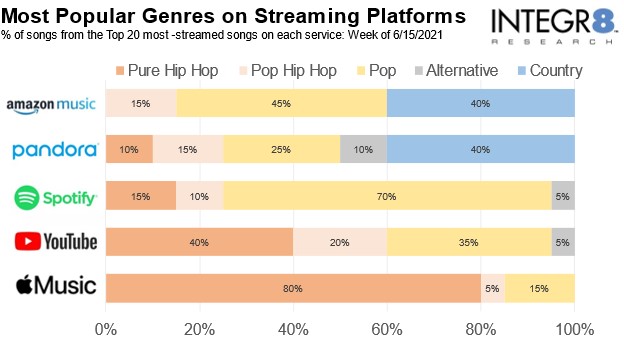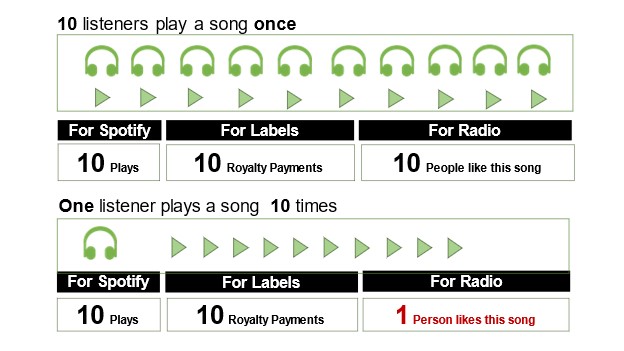Our 3rd post in our 3-part series exploring differences in the most popular songs on streaming platforms.
In our post examining a snapshot of the Top 20 songs on each of the five major streaming music services and in our review of Coleman Insights’ Contemporary Music SuperStudy3 data, we clearly saw differences in music tastes emerge among each service, namely:
- Country is huge among Amazon Music users, as are several timeless Classic Rock titles.
- Country is also big among Pandora users, but Pandora artificially removes titles from their charts after 17 to 24 weeks.
- Hip Hop dominates the most popular songs among Apple Music users.
- Hip Hop is also huge among YouTube music video viewers. Novelty songs are also popular on YouTube.
- Pop hits are big among Spotify users. Spotify listeners also use the service like a record store, streaming many tracks from new releases from favorite artists.

What do our findings mean for how you can most effectively use streaming data to pick the right contemporary music for your radio station? Here are five takeaways:
1) If you program a Country station, examine Amazon Music for the biggest Country hits and Pandora’s chart for the biggest up and coming songs. Whether it’s these services’ relatively older user bases or that both services have actively courted Country fans, Country programmers will find more of their P1s on these two services. Amazon Music tends to favor established Country hits, while Pandora’s artificial pruning of established titles means their charts will reflect the biggest up-and-coming titles.
2) If you program a Hip Hop station, examine Apple Music and YouTube. Both services have a higher percentage of pure Hip Hop fans than do other services. Historically, Hip Hop has also been huge on Spotify. Although Spotify’s most streamed songs are becoming more mainstream, the service remains a good place to see which Hip Hop titles are hot and have the potential to appeal beyond core Hip Hop fans.
3) If you program a CHR station, examine all these services—and look for consensus. As Spotify solidifies its position as the leading on-demand streaming service, its most streamed songs are increasingly representing mainstream tastes. The true measure of a mainstream hit, however, is how broad that song’s appeal is. By checking how a song is performing on multiple streaming services, you can see which songs have the universal appeal that makes a pop song a smash.
4) Look for those songs listeners stream week after week. Especially on Spotify and Apple Music, fans come to sample all the tracks from the latest releases from their favorite artists. While artists such as Drake, Ariana Grande, Migos, and Oliva Rodrigo have all dominated the Top 10 on Spotify or Apple Music for a week or two, the real hits from a new album will be those tracks listeners keep streaming week after week as a broader fan base discovers those songs. As a radio programmer needing to attract an audience beyond one artist’s core fans, it is important to look beyond what might be huge this week, and instead keep track of which songs listeners keep streaming week after week. Those songs are the real hits for your station.
5) Don’t judge the appeal of your format based on what’s streaming. If you don’t have the benefit of recent strategic perceptual research, you understandably want to gauge if the appeal for your format’s music is growing or waning. Are your ratings down because the format is less popular, or because of how you’re executing it?
Unfortunately, there are too many variables in who is using each streaming service to use their charts to judge your format.
For example, Country titles became more popular on Spotify at a time when the format’s ratings were down. Was Country music in general becoming more popular? Was Spotify’s user base expanding to include more Country fans? Or was that growth largely fueled by Morgan Wallen, an infamously famous artist appealing to younger listeners?
There’s one final thing to always keep in mind when using streaming data to pick current titles for your station:
In streaming, we’re examining song plays, not how many people like a song. Whether you’re examining an individual streaming service’s chart or aggregated streaming information on MRC Data’s BDS Radio or Alpha Data Music Charts, you are seeing how many total times users played a song. You are not seeing how many different people like that song.
In contrast, every other resource you’ve likely used to examine music appeal, from callout research to digital download sales, does measure the number of different people who like a song.

The distinction is important. Radio stations win by playing those songs that appeal to the most possible listeners within the format.
Occasionally, a song emerges among the most-streamed songs that’s obviously fueled by a small number of small listeners playing a song repeatedly.
And yes, we do mean “small listeners.”
While Idina Menzel’s “Let it Go” and Pingfong”s “Baby Shark” are huge on streaming thanks to toddlers with an excruciatingly high tolerance for repetition, the distinction is less obvious for songs that might appeal to teens and young adults who devote more time than do listeners 25 and older.
Until streaming services choose to publicly release information regarding the number of distinct individual users who play a song, programmers will need to evaluate the likelihood a song’s stream count stems from repeat plays more so than widespread appeal.
For more guidance on how to use streaming data to pick the right now music, check out our series How Streaming Data Can Help Radio Pick New Music.
| How to access charts for major music streaming services | |
 |
https://spotifycharts.com/regional |
| https://music.apple.com/browse/top-charts | |
 |
https://music.amazon.com/popular/songs |
| https://www.nextbigsound.com/charts/top-spins | |
| https://charts.youtube.com | |
